
Have you ever daydreamed about how to become an Instagram influencer?
If so, you’re not alone. After all, who doesn’t want to get paid to spend time on social media and work with exciting brands and products?
Influencer marketing is fast becoming the marketing industry’s favourite way of growing brand awareness and launching new products. The great news is; brands are keen to work with micro influencers – normal people with just a few thousand followers.
This means it’s never been easier to become a paid influencer – so your daydream about quitting your job and becoming an influencer is a very real possibility.
We’ve put together an in-depth guide that’ll explain exactly how to become an Instagram influencer – right the way from setting up, through to finding paid Instagram influencer jobs – including:
- What is a ‘lifestyle influencer’
- A step-by-step guide on how to become a social media influencer
- How do Instagrammers get so many followers?
- Some of the most popular influencer industries
What is an influencer?
If you’re reading this, you’re probably already familiar with the idea of an influencer – but what many people don’t realise is that you don’t have to be a superstar to be an influencer.
Strictly speaking, an influencer is anyone who has the power to influence another person’s behaviour. In social media terms, this is usually somebody with a good level of knowledge or experience in a certain niche – with a group of followers who are interested in the content they’re creating.
Some influencing is done fairly obviously – with product reviews or recommendations – but in other cases, just being seen with a product or talking about a certain brand is enough to influence your followers’ buying decisions.
Chances are, you probably follow plenty of influencers already. If they’re creating plenty of interesting content about subjects you like, they’re the kind of influencer that brands are keen to work with.
How many followers do you need to be an influencer?
If becoming an influencer sounds good, you’re probably wondering how many followers you need on Instagram to get paid.
The answer probably isn’t as many as you’re expecting.
In fact, there are different levels of influencer – from nano influencers right up to mega influencers and celebrities. We’ll take a look at the kind of follower numbers you would expect to see from each:
Nano influencers (< 1,000 followers)
Nano influencers are people with very small but very specific audiences. As a result, these low-follower-number accounts don’t have a very broad appeal – but you can bet their opinions carry a lot of weight in their online community.
A good example of a nano influencer would be an account that’s particularly interested in one very small location – a certain street or local area, for instance. While this kind of content will be fairly uninteresting to people outside that area, it’s likely to be a useful and regularly used source of knowledge for local residents.
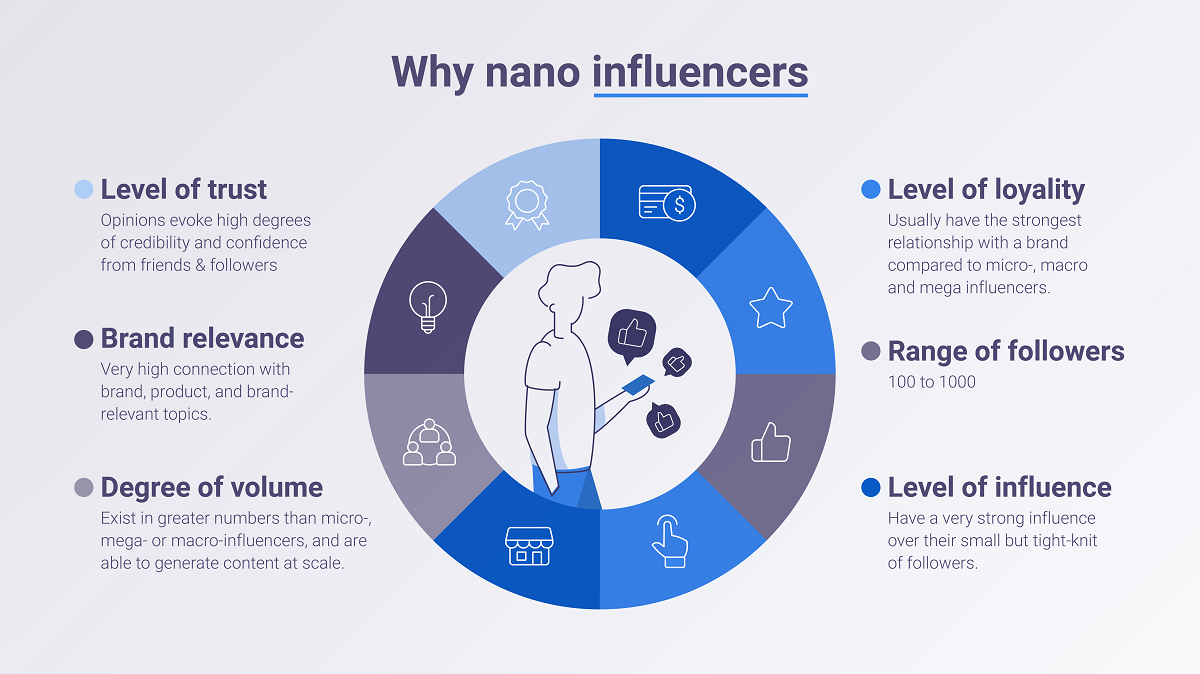
Nano influencers are a useful resource for companies that are looking to market to a very specific group of people – or hoping to create a large ‘groundswell’ of interest; hundreds – or even thousands – of people talking about a brand or product.
Micro influencers (1,000 – 100,000 followers)
Micro influencer level is the one that most commonly suits people who are starting out in their influencer career. Generally, micro influencers are normal people who have built up a following based on their knowledge about a certain subject.
Micro influencers tend to have great relationships and strong levels of engagement with their followers. While you probably won’t get much back if you try to talk to a celebrity online, micro influencers are different – and many will engage with your comments and likes, often even returning the love with likes and comments on your content.
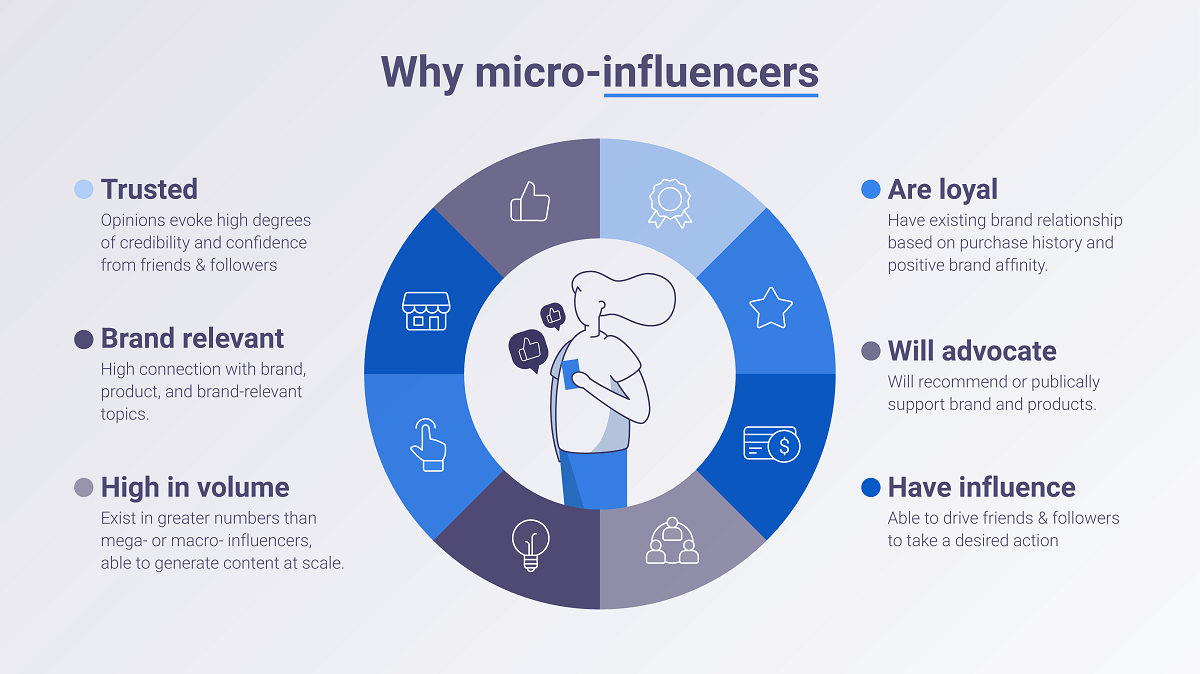
There are many mega influencers who spent a long time as micro influencers – managing their account alongside other work or study. Joe Wicks (aka. The Body Coach) spent a lot of his early career showing his 15-second recipes to a small number of fitness fans in Instagram – but he stuck at it, and now has millions of followers and subscribers on virtually every platform he uses.
Macro influencers (100,000 – 1m followers)
Macro influencers tend to be either celebrities who aren’t quite at the height of their fame – or ordinary people who’ve become very good at creating social media content that people want to see.
Realistically, these ordinary people are the kind of macro influencers that marketers like to use – owing to the fact that they’ve got large and dedicated audiences who’ve often followed their account for a long time.
At this level, influencers tend to have plenty of experience working with brands, so it’s often a fairly slick and hassle-free interaction when brands get together with macro-level accounts. That said, it can be a lot more difficult to detect when a macro influencer has bought followers – so brands need to go into any partnership with their eyes open.
Mega influencers (1m+ followers)
We all know of mega influencers. They might be superstar celebrities with millions of likes – or ordinary people who’ve catapulted themselves to fame by being the very best at producing outstanding content in their particular niche.
These are the PewDiePies, Kylie Jenners, and Cristiano Ronaldos of the world – but interestingly, fame doesn’t automatically make them the go-to choice for marketing teams. Realistically, mega influencers are only going to work with big brands – and they’re likely to charge at least 6-figures for doing so – so these kinds of collaborations are reserved for companies with astronomical budgets.
Why do brands like working with influencers?
Influencers represent one of the quickest growing areas of digital marketing – and that growth is all down to what an amazing job influencers can do.
Firstly, micro-level influencers are outstanding value for money – so brands can be confident they’re getting a solid return on their investment. What’s more, when a brand works with numerous lower-level influencers, they can expect a steady increase in brand awareness and sales – rather than a difficult-to-manage big hit that would come with a large celebrity endorsement.
Micro-level influencers also tend to make great, innovative content too – and they’re presenting that content to highly-engaged audiences in an authentic and genuine way.
This last point is absolutely key. Consumers can sense an inauthentic sponsored post from a mile away – and if it looks like a brand has just thrown money at a celebrity to promote a product they know nothing about, it can damage the reputation of everyone involved.
Ultimately, influencer marketing is word-of-mouth recommendations to the exact people a brand wants to attract – and since 84% of consumers trust recommendations from their peers more than they do over advertising – there really is no better way to build brand awareness.

Does Instagram pay you for followers?
Unlike YouTube, whether you’ve got 100 or 1 million Instagram followers, the platform will not pay you for your popularity.
This is down to the way the platform displays adverts. On YouTube, adverts are shown before, during, or over the top of your videos – so, the more viewers and subscribers, the clicks their adverts are likely to get. Instagram works a little differently though – with adverts shown between posts as a user scrolls their feed.
As such, your follower count doesn’t influence the number of views their products get – but that doesn’t mean followers won’t get you paid. Brands will often use your follower count as the first metric they look at when they consider working with you. Be warned though – it’s not the only metric they use, so don’t be tempted to pay for fake followers!
As well as your follower count, brands will look at your follower engagement rate – i.e. how often they’re liking and commenting on your content. The better your engagement rates, the more likely you are to be paid to promote a brand.
How to be an influencer – a complete guide
If you came here looking at how to become an influencer on Instagram, Facebook, YouTube or any other social media platform – this is the guide you’re going to need.
We’ve put together a 10-point list that leaves nothing to chance when you’re becoming a social media influencer. There are other guides out there – but if you’re going to do it, you want to make sure you’re doing the very best possible job of creating a personal brand that paying companies will want to work with.
1. Pick an industry or ‘niche’
Most people’s social media accounts don’t attract more than a few hundred followers.
Why?
It’s usually because their content is too broad. Cat pictures, holiday shots, the occasional latté, and a meme or two might make your friends and family hit ‘like’ – but unless you’re a Hollywood A-lister, the wider world isn’t really going to be interested.
As such, you need to get focused. The first thing to think about is the specific niche you’d like to work in. ‘Like’ is an important word here – because unless you enjoy what you’re doing, you’re probably not going to give it your all.
What should you choose?
Think about what you know a lot about – and what you’re good at.
You might want to flick back through your social media feeds to see what’s been popular in the past. If you’ve mastered the art of creating amazing looking lunches – then maybe you’ll want to explore how to become a food influencer. Then again, if your gym routines and workout posts get a lot of love, you might decide to explore how to become a fitness influencer.
Try to stick to 1, 2, or a maximum of 3 areas to concentrate on. You might be knowledgeable about more industries or niches, but if you combine too many things, you’ll end up with an audience that’s too broad and little use to brands.
What’s popular?
At that moment, influencer marketing is most popular in the following industries:
- Fashion and beauty
- Travel and lifestyle
- Business and tech
- Entertainment
- Home and family
Of course, you can still be successful in other areas – but these are the most sought after by brands. Again, narrowing things down within these niches is a good idea – so if you pick fashion and beauty, you don’t have to become the next Grazia – you could even narrow your focus, so you’re just creating content about clutch bags, heels, or seasonal jackets – for instance.
2. Choose your platform
Becoming a social media influencer requires a bit of research – not least around which social media platform you’re going to choose to share your content.
Sometimes, the choice will be obvious. If you’re looking into how to become beauty influencer, you’ll need a platform that’s focused on video and pictures – so Instagram’s likely to be the network for you. Then again, if you’re looking to create content that’s business-focused, you might look into platforms that are more frequently used for professional networking – like LinkedIn.
Take a look at the demographics you can expect to connect with on the different social media services:
If you’re not sure, Instagram is a firm favourite with influencers. In fact, studies suggest that 93% of influencers choose Insta thanks to its wide appeal and simplicity of use.
If you do choose to work across more than one platform, it’s important to make sure you understand how each service works and then tailor your content so that it works perfectly on each.

3. Work on creating a brand
Don’t be fooled into thinking that a ‘brand’ is something that’s reserved for big companies with marketing teams. Everyone has a brand – it’s the persona that they apply to themselves and their content when they’re working online.
When you’ve decided which platforms you’re going to be working on, you’re going to need to do a quick audit of your profile(s) to make sure they line up with the work you’re going to be doing.
Business accounts
It’s a good idea to switch to business accounts if you’re using Facebook, Instagram, or Twitter. These give you more options and plenty of audience information to help inform what you’re doing.
Add profile pictures and cover photos
Lots of people recognise a social media account based on its profile picture – so make sure yours is good.
Think about picking a bold background, wearing a colour that pops, and making sure you can see your face clearly. It goes without saying that you should make sure it’s a high-quality image too. You’re going to want to stick with this image for a while, so ensure you’re happy with it!
While a picture of your dog or a nice holiday snap might work for a cover photo for a personal account, you might want to pick something that reflects your niche since you’re going to be an influencer. Try to find a picture that gives an idea of what you do – as it’s going to be one of the first things people see when they hit your page.
Write a good bio
Your bio is going to tell people what you’re all about when they take a glance at your profile – so make it good.
Make it clear what people can expect to see if they follow you – and make sure you’ve included your name and some contact details, so brands can get in touch.
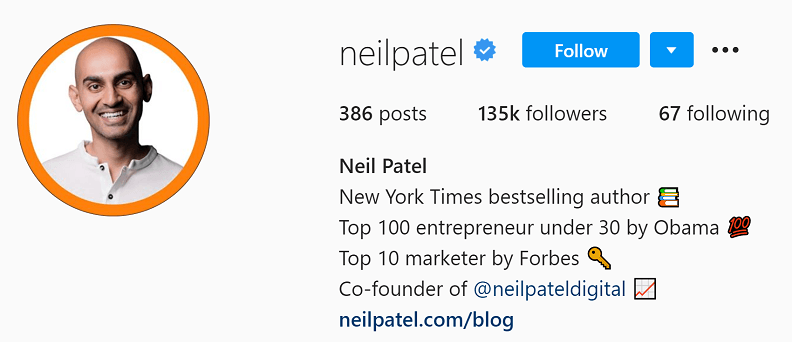
4. Research how to create outstanding content
It’s no over-exaggeration to say that an influencer’s career can live or die based on the quality of the content they share.
Great content is the start of everything. Shoot brilliant pictures or create amazing video and you’ll get the likes and comments you deserve. In turn, those likes and comments are opportunities to grow and engage your audience.
So, get out there and look at other great content – think about what makes it great and try to build that into what you’re going to do.
Creating a content strategy
It’s also a great idea to have a solid content strategy. Again, this might sound like something that’s reserved for big brands – but if you one-day want to become a big influencer, it’s a good idea to start thinking like one now.
As an example, let’s say you’re considering how to become a fashion influencer. You already know that fashion is seasonal – so, like the major fashion magazines, you’re going to want to be creating content around next season’s trends to keep you relevant and ahead of the game. Alongside this, you might decide you want to run different features – for instance, recent brand collaborations as they happen – or coverage of events in the fashion calendar.
Take a glance at the @lindseyholland_ account to see this kind of approach in action. The fashion blogger’s feed combines coverage of events, collaborations, releases and seasonal collections – which are unquestionably planned and carefully curated to keep her ahead of the curve.
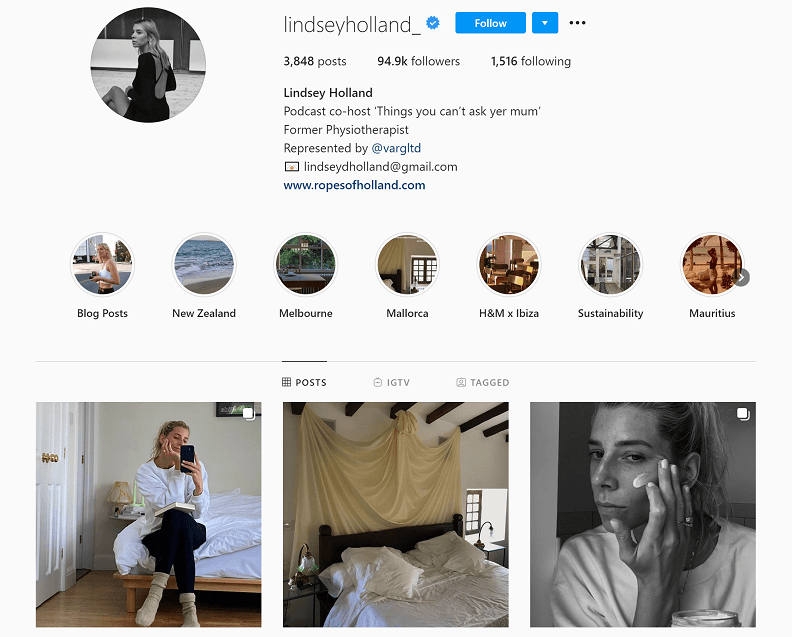
This all might sound obvious – but if you don’t plan these things in advance, you’re going to find that you don’t have the right information or products to really keep ahead of the game. Open your calendar app – and start thinking about what your audience is going to want to see – and when they’ll be looking for it.
5. Understand hashtags
When you have thousands of followers – you’re going to find that you lose some – or that some stop engaging quite as much as they did when they first followed you.
This is natural – so don’t worry about. Instead, you need to think about how you can always make sure you’re exposing your content to new people. One of the best ways to do this is with hashtags.
What are other people using?
Using the right hashtags will involve a bit of research. Take a look at successful accounts in your chosen niche and look into their hashtag game. Also, look at big brands – they’re investing a lot of money in social media marketing – so don’t be afraid to take inspiration from their hard work.
As an example, if you’re considering how to become a travel influencer, the Insta account @wearetravelgirls is worth a look. The team use hashtags that combine the location they’re featuring with more general travel phrases – so whether people are generally interested in the field – or they’re looking for a specific location, the account’s likely to appear:
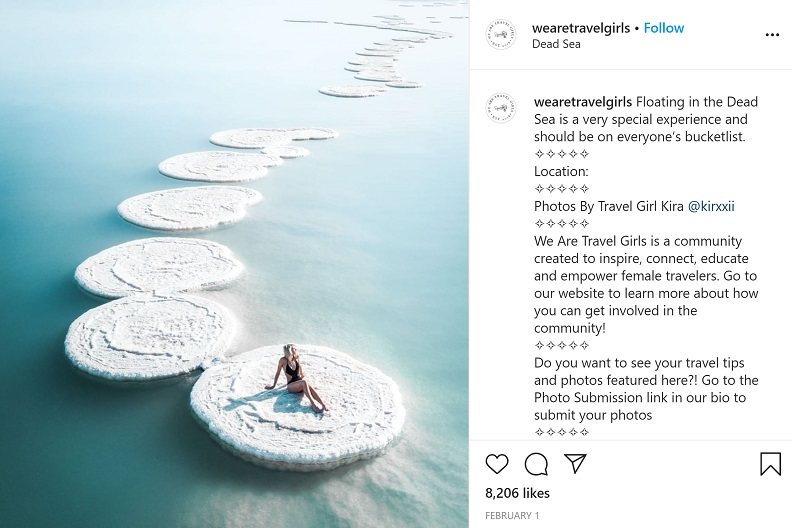
Don’t just cut and paste
Be warned – don’t just be tempted to cut and paste a standard list of hashtags you’ve found into every post you create. Both Facebook and Instagram have algorithms that can spot this kind of approach – and you’ll only get away with it a few times before the platforms penalise you and show your content further down in search results.
The short version is this: make sure you use fresh and relevant hashtags!
6. Put in the work!
If you’re looking into how to be an Instagram influencer because you think it’ll only involve 10 minutes of work a day – now’s the time to reconsider!
If you’re going to make yourself known as an influencer, it’s a good idea to treat it like a job. Sure, it doesn’t have to involve sitting at a desk from 9-5 – but you’re going to need to become a bit of an expert in your field – and you’ll want to stay on top of what other people in your niche are doing.
If possible, aim to publish content daily – but you should never let a high-frequency of content compromise the quality of your posts. Try put your content together at least a few days in advance – so if anything unforeseen happens, you’ve got a few days of posts/videos already created and ready to go.
7. Connect and collaborate with other influencers
While you’ve been doing all the research we’ve been talking about, you’ve no doubt come across plenty of influencers in your niche. You might look at their content and think you can do better – or you might just be looking on in admiration, hoping to one-day hit the same levels of popularity.
Either way, it’s important to remember that these people are not your rivals. Whether they’ve got 100 or 100,000 followers, they’re people who are chasing their dream, just like you.
As such, you’ve probably got a lot in common – so why not reach out and connect? Start by making yourself a regular face in their likes and comments – then, talk about collaborations. You don’t have to be sliding into celebrity DMs either – micro influencers can help businesses grow; so working together can help you both grow.
8. Consider putting a simple website together
Wait – do you really need a website when you’ve got perfectly good social media accounts?
Well, no – but it can lift you above other influencers, making you look that little bit more polished and professional.
Take Marques Brownlee and his MKBHD brand, for example. As one of the biggest and best tech influencers on YouTube, his content is easy to find – but he also owns MKBHD.com. If you’re expecting his site to be a sprawling resource packed with videos – you’d be wrong – it’s a quick bio, some contact details, and links to his social media accounts.
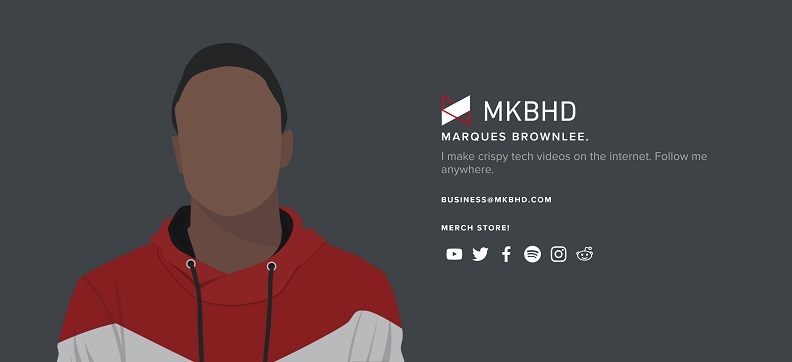
You can use a simple website builder to put a site like this together for just a small monthly fee – and when brand employees search for you on Google, it’s likely to appear; boosting your credibility. You’ll even be able to incorporate your social media feeds, so it’ll give people who are looking a real-time snapshot of what you’re doing.
Having your own website and domain name also means you can ditch that @hotmail.com email address too – just another little touch that’ll make you look like an influencer who’s taking the job seriously.
9. Create exciting events
Ever shared, liked, commented, retweeted, or generally got involved with a brand because they were running an AMA (ask me anything), a contest, or a great giveaway?
Virtually everyone has – so doing the same is an amazing way to encourage engagement from your followers or subscribers.
Contest and giveaways need some serious organisation. You’ll need to be clear with the rules, set out a deadline – and follow through with your reward. What’s more, you’ll need to make sure you announce your winner exactly when you say you will – otherwise you’re going to end up leaving people frustrated!
So, if you can plan an event properly, you’re likely to keep your followers engaged – and hanging around for future events.
10. Engage with your fans
Rule number one when you’re an influencer is to engage with your followers and subscribers.
Sure, if you’re a Kardashian, this isn’t really necessary – because people are interested in you anyway – but until you’ve achieved superstardom, you’re going to need to keep a solid connection with your audience.
Try to acknowledge every comment or DM that comes your way from genuine followers. People are getting in touch because they like your content – and giving them your attention in return confirms that connection – helping you stay relevant and continue to influence the decisions they’re making.
Ready for life as an influencer?
If you’ve read through our ‘how to be a brand influencer guide’ and you’re not put off by the work involved, now’s the time to scroll back to step 1 and get started.
It doesn’t matter whether you’re exploring how to be a model on Instagram or hoping to become the next PewDiePie on YouTube, it’s important that you remember one thing:
Brands are going to love you because you’re genuine, authentic, and engaging.
These aren’t things you can fake. There’s no amount of bought followers or fake recommendations that’ll make you look good – you just have to get out there, create great content, and engage with your followers.
When you’ve got these basics in place, we can help you take the next steps - growing your following to levels you probably never thought were possible.